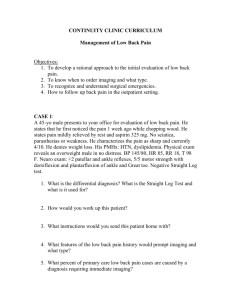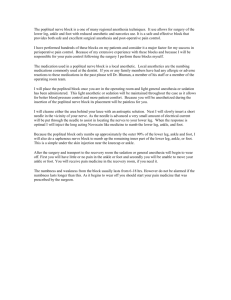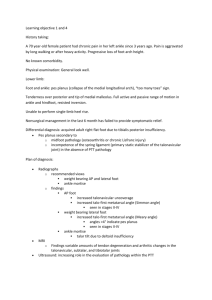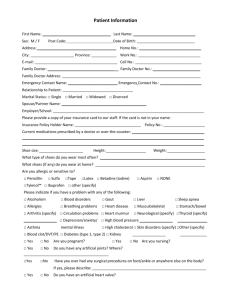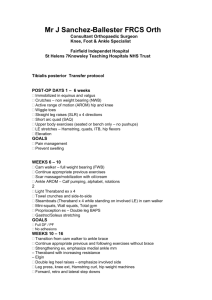Transverse Plane Motion at the Ankle Joint
advertisement
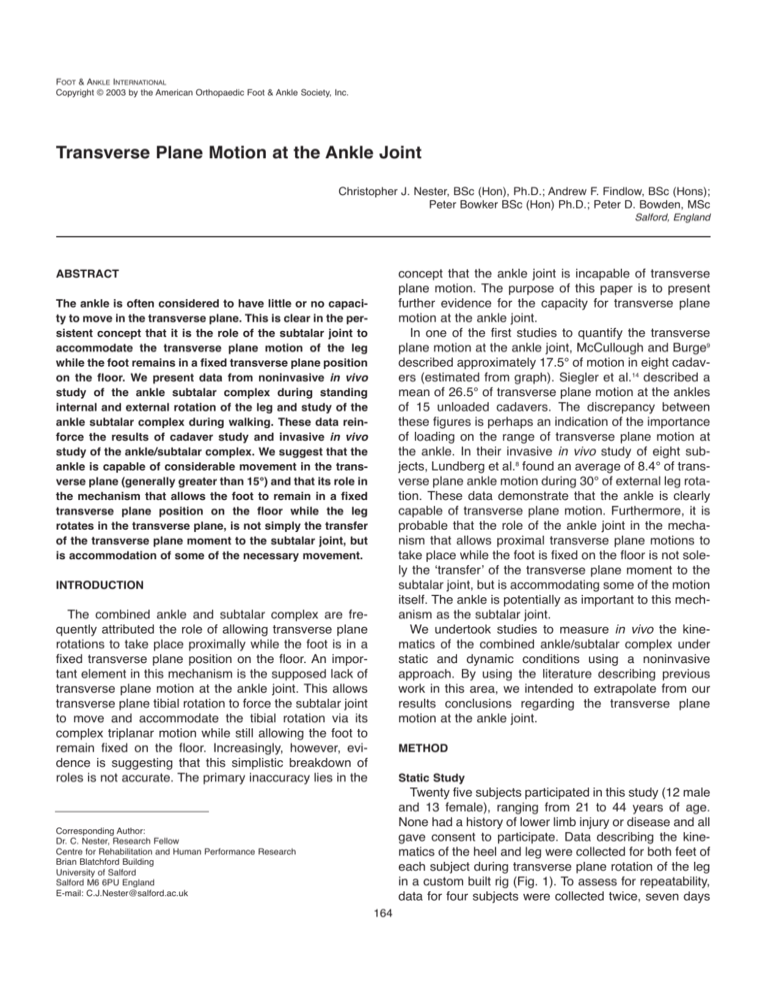
FOOT & ANKLE INTERNATIONAL Copyright © 2003 by the American Orthopaedic Foot & Ankle Society, Inc. Transverse Plane Motion at the Ankle Joint Christopher J. Nester, BSc (Hon), Ph.D.; Andrew F. Findlow, BSc (Hons); Peter Bowker BSc (Hon) Ph.D.; Peter D. Bowden, MSc Salford, England concept that the ankle joint is incapable of transverse plane motion. The purpose of this paper is to present further evidence for the capacity for transverse plane motion at the ankle joint. In one of the first studies to quantify the transverse plane motion at the ankle joint, McCullough and Burge9 described approximately 17.5° of motion in eight cadavers (estimated from graph). Siegler et al.14 described a mean of 26.5° of transverse plane motion at the ankles of 15 unloaded cadavers. The discrepancy between these figures is perhaps an indication of the importance of loading on the range of transverse plane motion at the ankle. In their invasive in vivo study of eight subjects, Lundberg et al.8 found an average of 8.4° of transverse plane ankle motion during 30° of external leg rotation. These data demonstrate that the ankle is clearly capable of transverse plane motion. Furthermore, it is probable that the role of the ankle joint in the mechanism that allows proximal transverse plane motions to take place while the foot is fixed on the floor is not solely the ‘transfer’ of the transverse plane moment to the subtalar joint, but is accommodating some of the motion itself. The ankle is potentially as important to this mechanism as the subtalar joint. We undertook studies to measure in vivo the kinematics of the combined ankle/subtalar complex under static and dynamic conditions using a noninvasive approach. By using the literature describing previous work in this area, we intended to extrapolate from our results conclusions regarding the transverse plane motion at the ankle joint. ABSTRACT The ankle is often considered to have little or no capacity to move in the transverse plane. This is clear in the persistent concept that it is the role of the subtalar joint to accommodate the transverse plane motion of the leg while the foot remains in a fixed transverse plane position on the floor. We present data from noninvasive in vivo study of the ankle subtalar complex during standing internal and external rotation of the leg and study of the ankle subtalar complex during walking. These data reinforce the results of cadaver study and invasive in vivo study of the ankle/subtalar complex. We suggest that the ankle is capable of considerable movement in the transverse plane (generally greater than 15°) and that its role in the mechanism that allows the foot to remain in a fixed transverse plane position on the floor while the leg rotates in the transverse plane, is not simply the transfer of the transverse plane moment to the subtalar joint, but is accommodation of some of the necessary movement. INTRODUCTION The combined ankle and subtalar complex are frequently attributed the role of allowing transverse plane rotations to take place proximally while the foot is in a fixed transverse plane position on the floor. An important element in this mechanism is the supposed lack of transverse plane motion at the ankle joint. This allows transverse plane tibial rotation to force the subtalar joint to move and accommodate the tibial rotation via its complex triplanar motion while still allowing the foot to remain fixed on the floor. Increasingly, however, evidence is suggesting that this simplistic breakdown of roles is not accurate. The primary inaccuracy lies in the METHOD Static Study Twenty five subjects participated in this study (12 male and 13 female), ranging from 21 to 44 years of age. None had a history of lower limb injury or disease and all gave consent to participate. Data describing the kinematics of the heel and leg were collected for both feet of each subject during transverse plane rotation of the leg in a custom built rig (Fig. 1). To assess for repeatability, data for four subjects were collected twice, seven days Corresponding Author: Dr. C. Nester, Research Fellow Centre for Rehabilitation and Human Performance Research Brian Blatchford Building University of Salford Salford M6 6PU England E-mail: C.J.Nester@salford.ac.uk 164 Foot & Ankle International/Vol. 24, No. 2/February 2003 TRANSVERSE PLACE ANKLE MOTION 165 To reduce the volume of data, the angular data from the rotation of the leg from an externally rotated position to an internally rotated position, and the angular data from the rotation of the leg from an internally rotated position to an externally rotated position were averaged. The characteristics of rearfoot motion are the same during these two rotations, though the directions of motion are reversed.1,5 The characteristics of the ankle/subtalar complex were described using the range of motion in each cardinal body plane and the orientation of the axis of rotation. This latter quantity was calculated using a vector summation method previously used by Downing et al.4 Fig. 1: Shows experimental rig used during static assessment. Rig was based on design used by Van Langelaan.15 Reflective markers can be seen on the leg, heel and forefoot (forefoot markers were part of separate study). Black lines indicate motion of leg and foot during internal leg rotation, white line the motion of the leg and foot during external leg rotation. Fig. 2: Marker set used for dynamic study on four subjects. Four markers were mounted onto a plate attached to the leg, and three markers were attached to the heel cup. Also visible are an additional heel marker and markers on four anatomical landmarks on the leg. These were used to define anatomically relevant local coordinate systems for the leg and heel. apart. Kinematic data for each segment were derived by tracking the position of three reflective markers attached to the heel and the leg, from which local coordinate systems were subsequently defined. Using these local coordinate systems, the transverse, sagittal and frontal plane motions of the heel relative to the leg were calculated in the planes of the global reference system. Each subject moved through the following movement sequence. The leg was in external rotation and the foot supinated to the extent that the first metatarsal was non-weightbearing (Fig. 1). The subject then internally rotated their leg to the point of maximum internal leg rotation (black lines in Fig. 1) and the subject then externally rotated the leg to return to the original start position (white lines in Fig. 1). Ten consecutive recordings of this motion sequence were taken. Dynamic Study In this preliminary study, conducted by the second author (AF), the three dimensional motion of the heel relative to the leg during barefoot walking was measured using reflective markers attached to each segment. The data collection protocol was similar to that of the static study in terms of marker locations, but followed the guidelines of the calibration method detailed by Cappozzo et al.2,3 so that skin movement artefacts were reduced. The leg was defined using reflective markers mounted on a plastic platform moulded and attached to the front of the leg and using the tibial tuberosity, fibular head, medial and lateral malleoli as calibration (anatomical) landmarks. The heel was defined using three markers attached to a heel cup (Fig. 2). Four male subjects were tested to provide preliminary data. Twenty gait cycles were recorded for each limb of each subject and all the data combined to produce average data representing the eight limbs. RESULTS The mean range of ankle/subtalar complex motion during internal and external rotation of the leg (mean of 48 limbs) was 27.2° (SD 4.3°, range 19.6° to 35.4°) in the transverse plane, 7.6° (SD 5.2°, range -0.7° to 24.3°) in the frontal plane and -0.7° in the sagittal plane (SD 2.3°, range -7.5° to 6.3°). This indicates that during internal leg rotation the heel everted and abducted relative to the leg, and during external rotation the heel inverted and adducted relative to the leg. The direction of motion in the sagittal plane was highly variable and was dependent on the motion of the leg, rather than motion of the heel. The range of frontal and transverse plane motion at the ankle/subtalar complex of each of 48 limbs is detailed in Figure 3. The difference between days in the transverse and frontal plane ranges of motion measured for four subjects were on average 1.2° and 1.0° for the transverse and frontal planes respectively. The mean axis of rotation (calculated from the mean range of 166 NESTER, FINDLOW, BOWKER AND BOWDEN Foot & Ankle International/Vol. 24, No. 2/February 2003 motion) for the ankle/subtalar complex was angled 74.3° relative to the transverse plane and -5.4° to the sagittal plane, and is illustrated in Figure 4. The mean data for the motion at the ankle/subtalar complex (motion of the heel relative to the leg) during walking are presented in Figure 5. These data are the average of the eight limbs from the four subjects. DISCUSSION The clear predominance of transverse plane motion at the ankle/ subtalar complex during the static assessments is consistent with an in vivo study of the maximum range of motion at the ankle/subtalar comFig. 3: Illustrates the range of motion in the transverse and frontal planes at the ankle/subtalar plex (actively produced by free rotacomplex during our static assessment. Data is detailed for each limb of each subject except tion of the foot by the subjects). Nigg two limbs for which data was lost. et al.11 described a mean total of 35.5° of frontal plane motion and 72.4° of transverse plane motion at an equivalent of the ankle/subtalar complex in subjects aged 20 to 39. The difference in the ratio of transverse to frontal plane motion in the latter study compared to this current study Mean ankle/subtalar complex is most likely due to the fact that foot motion was proaxis (74.3°) from static study. duced by muscle contraction in the Nigg et al. study. The musculature around the ankle/subtalar complex is better orientated for producing frontal plane motion than transMean subtalar joint axis (33.5°) taken from comparable verse plane motion. Thus, it is unlikely that these indidata from Lundberg et al. viduals were able to exploit the full range of transverse plane motion. In this study, where body weight and proximal transverse plane rotations were used to produce ankle/subtalar motions, it is more likely that the full range of transverse plane ankle/subtalar complex motion was exploited. The angulation of the ankle/subtalar axis to the transverse plane calculated from the data from the static study was consistently high, ranging from 53.2° to 88.9° and this reflects the predominance of transverse plane Fig. 4: Axes of rotation for the ankle/subtalar complex as calculated motion at the complex. This angulation of the axis is in our static study, and the axis of rotation for the subtalar joint generally greater than that of the subtalar joint, which described by Lundberg et al. The difference in angulation to the has been reported to range between 20° and 68°.6,7 This transverse plane of the axes reflects the increased transverse plane motion at the combined ankle/subtalar joints compared to the subtareflects the greater range of transverse plane motion lar joint in isolation, and thus the transverse plane motion taking available at the combined ankle and subtalar joints and place at the ankle joint. suggests that the ankle joint is moving a considerable degree in the transverse plane. However, these results for the combined ankle/subtalar complex must be furThe literature describes a variety of functional characther interpreted to elicit any characteristics of solely the teristics for the subtalar joint, including subtalar joints ankle joint. that display more transverse than frontal plane motion 7 7 Foot & Ankle International/Vol. 24, No. 2/February 2003 Fig. 5: Illustrates the transverse, frontal plane and sagittal motion at the ankle/subtalar complex during our dynamic study (Figs in degrees for 100% of stance). FF = Forefoot contact, HO = Heel off, see text for explanation of . Positive values indicate internal leg rotation, heel eversion and dorsiflexion. and those that display more frontal than transverse plane motion.1,8,15 These variations in the predominant motion at the subtalar joint have been evident in all studies of the subtalar joint characteristics, and samples have generally been much smaller than in this investigation. It is reasonable to assume, therefore, that the group investigated in this study will also possess such variations in characteristics of the subtalar joint. Assuming this is the case, then some deductions can be made about the transverse plane motion at the ankle joint. Some subjects in the static study, displayed more than half as much frontal plane ankle/subtalar complex motion as there was transverse plane motion during the composite phase (the ratio value of transverse to frontal plane motion was less than 2) (Fig. 3). Since it is known that the principal source of frontal plane motion at the ankle/subtalar complex is the subtalar joint,13 and within our sample these subjects display the largest range of frontal plane motion, then these individuals probably possess a subtalar joint that displays more frontal than transverse plane motion. If this is the case, then the ankle joint must typically be moving approximately 15° in the transverse plane. In contrast, some subjects in the static study displayed very little frontal plane motion at their ankle/subtalar complex (Fig. 3). As we reported earlier, McCullough and Burge9 and Siegler et al.14 have described transverse plane rotations of similar to these hypothetical figures. More recently, Michelson et al.10 have reported transverse plane motion in excess of 8° at the ankle joint during simple plantar and dorsiflexion of the leg relative to the foot. This is a considerable degree of motion given that their experimental set up probably produced little or no external transverse plane moment at the ankle. Clearly then, the range of transverse plane motion through which the TRANSVERSE PLACE ANKLE MOTION 167 ankle might move, as suggested by the results of our static study and in the context of other evidence regarding the ankle joint, are quite feasible. If the range of transverse plane ankle joint motion suggested here is correct, then in general the ankle and subtalar joints contribute approximately equal amounts of transverse plane motion to the overall function of the ankle/subtalar complex. This would be consistent with other literature that has assessed the ankle and subtalar joint separately. Siegler et al.14 reported 26.5° of transverse plane ankle motion and 25.9° of transverse plane subtalar joint motion during transverse plane rotation of the foot relative to the leg. Rosenbaum et al.13 described a mean total of 11.1° of transverse plane motion at the ankle joint and 12.3° at the subtalar joint during transverse plane rotation of the foot relative to the leg. The principal difficulty with the discussion so far is that all the results are from studies of the ankle/subtalar complex under static conditions. However, the data from our dynamic study provides further weight to the evidence that the transverse plane motion at the ankle joint should be considered in how we conceptually model the ankle joint. The data presented demonstrate that transverse plane ankle motion is utilised during walking, and is not simply a characteristic evident in static studies. During the period from forefoot contact to point indicated on the graph (Fig. 5), the leg is externally rotating with respect to the heel, and this occurs independent of inversion of the heel relative to the leg, which remains comparatively constant. This is similar to data reported by Rattanaprasert et al.12 If the external rotation of the leg during this period were occurring solely at the subtalar joint then the coupled inversion motion would have to occur at the same time, which it does not. The most likely mechanism by which this external rotation can take place without concurrent inversion of the heel is by external rotation of the leg relative to the talus. This is in agreement with Van Langelaan15 who observed that during initial external rotation of the tibia, the talus did not follow the tibia immediately. This “talar delay” was attributed to the need to develop tension in the ankle ligaments before the talus would follow the leg into external rotation. SUMMARY The ability of the ankle joint to move in the transverse plane is clearly an important part of the kinematic chain which allows the leg and proximal structures to rotate in the transverse plane while the foot remains in a relatively fixed transverse plane position on the floor. Our static and dynamic studies using a noninvasive in vivo method have confirmed the findings of other studies that have concluded that both the ankle joint and the 168 NESTER, FINDLOW, BOWKER AND BOWDEN subtalar joint are necessary parts of this mechanism and it is not solely a function of the subtalar joint. REFERENCES 1. Benink, RJ: The constraint-mechanism of the human tarsus. A roentgenological experimental study. Acta Orthop Scand Suppl, 215:1-135, 1985. 2. Cappozzo, A; Catani, F; Croce, UD; Leardini, A: Position and orientation in space of bones during movement: anatomical frame definition and determination. Clin Biomech (Bristol, Avon), 10:171178, 1995. 3. Cappozzo, A; Catani, F; Leardini, A; Benedetti, MG; Croce, UD: Position and orientation in space of bones during movement: experimental artefacts. Clin Biomech (Bristol , Avon ), 11:90-100, 1996. 4. Downing, JW; Klein, SJ; D’Amico, JC: The axis of motion of the rearfoot complex. J Am Podiatry Assoc, 68:484-499, 1978. 5. Hintermann, B; Nigg, BM: [Movement transfer between foot and calf in vitro]. Sportverletz Sportschaden, 8:60-66, 1994. 6. Isman, RE; Inman, VT: Anthropometric studies of the foot and ankle. Bull Prosthetics Research, 10:97-129, 1969. 7. Lundberg, A; Svensson, OK: The Axes of Rotation of the Talocalcaneal and Talonavicular Joints. The Foot, 3:65-70, 1993. 8. Lundberg, A; Svensson, OK; Bylund, C; Selvik, G: Kinematics Foot & Ankle International/Vol. 24, No. 2/February 2003 of the ankle/foot complex – Part 3: Influence of leg rotation. Foot Ankle, 9:304-309, 1989. 9. McCullough, CJ; Burge, PD: Rotatory stability of the load-bearing ankle. An experimental study. J Bone Joint Surg Br, 62-B:460464, 1980. 10. Michelson, JD; Schmidt, GR; Mizel, MS: Kinematics of a total arthroplasty of the ankle: comparison to normal ankle motion. Foot Ankle Int, 21:278-284, 2000. 11. Nigg, BM; Fisher, V; Allinger, TL; Ronsky, JR; Engsberg, JR: Range of motion of the foot as a function of age. Foot Ankle, 13:336-343, 1992. 12. Rattanaprasert, U; Smith, R; Sullivan, M; Gilleard, W: Threedimensional kinematics of the forefoot, rearfoot, and leg without the function of tibialis posterior in comparison with normals during stance phase of walking. Clin Biomech (Bristol , Avon ), 14:14-23, 1999. 13. Rosenbaum, D; Becker, HP; Wilke, HJ; Claes, LE: Tenodeses destroy the kinematic coupling of the ankle joint complex. A threedimensional in vitro analysis of joint movement. J Bone Joint Surg Br, 80:162-168, 1998. 14. Siegler, S; Chen, J; Schneck, CD: The three-dimensional kinematics and flexibility characteristics of the human ankle and subtalar joints – Part I: Kinematics. J Biomech Eng, 110:364-373, 1988. 15. Van Langelaan, EJ: A kinematical analysis of the tarsal joints. An X-ray photogrammetric study. Acta Orthop Scand Suppl, 204:1269, 1983.


